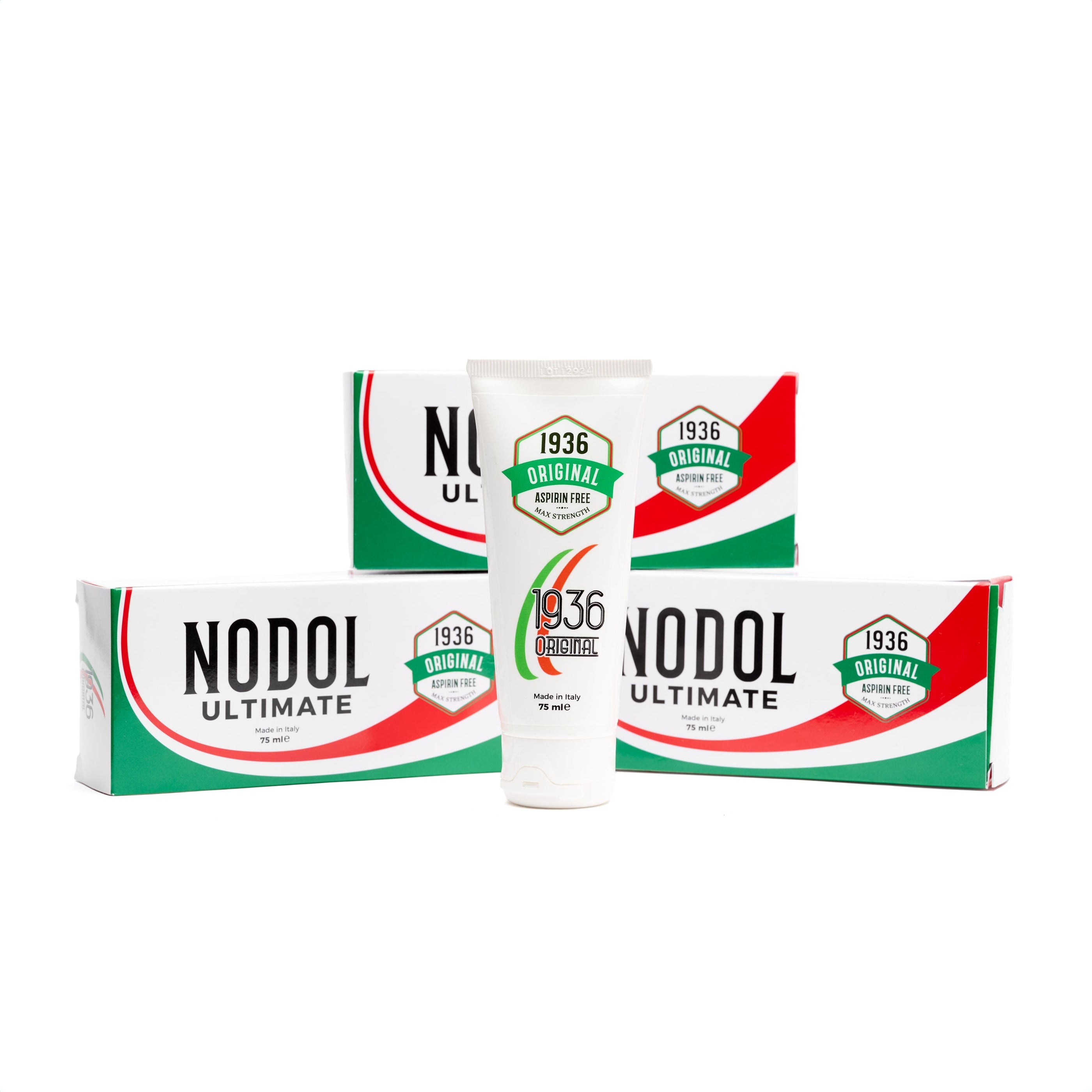Prescription vs Non-Prescription Pain Relief: What You Need to Know

Introduction
Pain management is crucial for maintaining a good quality of life, and knowing the difference between prescription and non-prescription pain relief options can be really important. This article explores the various choices available, looking at both prescription pain relief and non-prescription alternatives. Whether you're dealing with long-term conditions or occasional discomforts, picking the right treatment can have a big impact on your well-being.
When looking into options like the best over-the-counter medication for arthritis or finding effective over-the-counter medicine for common body aches, it's essential to consider the pros and cons of each type. Both prescription and non-prescription solutions have their own benefits but also come with possible side effects and limitations.
But it's also worth looking into other ways to relieve pain. Natural health solutions can provide effective relief without the side effects often associated with pharmaceuticals. By considering these factors, you can make an informed decision about what might work best for your specific needs.
Understanding Prescription Pain Relief Solutions
Prescription pain relief solutions are tailored for managing a range of pain conditions, providing options that are not typically available over the counter. These medications are usually prescribed by healthcare professionals after a thorough assessment of your specific needs and medical history.
Common Types of Prescription Medications:
- Opioids: Widely used for severe pain management, opioids such as hydrocodone, oxycodone, morphine, and fentanyl are potent drugs. While effective, they carry significant risks of addiction and dependence due to their strong action on the brain's pain pathways.
- Nerve Pain Medications: Conditions involving nerve-related pain often require medications like gabapentin and pregabalin. These work by stabilising electrical activity in the nerves to reduce pain signals.
- Antidepressants: Certain antidepressants have dual roles in pain management, particularly for chronic conditions. They modify neurotransmitters in the brain to alter pain perception.
- Corticosteroid Injections: For inflammatory conditions affecting joints, corticosteroid injections can offer temporary relief by reducing swelling and discomfort.
Prescription medications come with their share of risks. Addiction is a primary concern with opioids, while other medications may lead to side effects such as dizziness, gastrointestinal issues, or mood changes. It's crucial to weigh these risks against the benefits under professional guidance.
However, understanding these options allows you to make informed decisions about managing your pain effectively and responsibly. This knowledge prepares you for conversations with your healthcare provider about potential treatments tailored to your specific needs.
In addition to prescription medications, there are also natural alternatives available for pain relief. For instance, 1936 Original offers a range of natural pain relief products that could complement your treatment plan. Their Original Five Pack, which includes a strong pain cream made in Italy since 1936, is designed for fast absorption and effectiveness across all ages. Such options provide an additional layer of flexibility in managing your pain while minimising the risk associated with some prescription medications.
Exploring Non-Prescription Pain Relief Solutions
Non-prescription pain relief options, often referred to as over-the-counter (OTC) medications, provide accessible solutions for managing mild to moderate pain. These options are available without a prescription and can be an effective first line of treatment for many individuals.
Types of Non-Prescription Medications
1. Acetaminophen (Tylenol)
Widely used for its ability to alleviate mild to moderate pain and reduce fever. Its mechanism involves inhibiting the production of prostaglandins in the brain, which helps decrease pain perception. Acetaminophen is generally considered safe when taken as directed, but an overdose can lead to severe liver damage.
2. Non-steroidal anti-inflammatory Drugs (NSAIDs)
This category includes popular medications such as aspirin, ibuprofen (Advil, Motrin), and naproxen (Aleve). NSAIDs work by blocking enzymes that produce prostaglandins, substances responsible for inflammation and pain. They are effective in reducing swelling and providing relief from conditions like arthritis and menstrual cramps. Regular use may increase the risk of stomach ulcers and bleeding.
Topical Medications and Self-Care Measures
3. Topical Medications
Creams or gels containing NSAIDs or anaesthetics like lidocaine can be applied directly to painful areas. These offer localised relief with fewer systemic side effects compared to oral medications.
4. Self-Care Measures
Techniques such as heat therapy (using heating pads) or cold therapy (applying ice packs) can help manage pain by improving circulation or reducing swelling.
Understanding these non-prescription options allows you to make informed decisions about managing pain effectively while minimising potential risks.
Comparing Effectiveness Between Prescription and Non-Prescription Pain Medications
When deciding between prescription and non-prescription pain relief solutions, understanding the severity of the pain is crucial.
1. Mild Pain
Typically managed with non-prescription options such as acetaminophen or NSAIDs. These medications are effective for headaches, muscle aches, and minor injuries. Their ease of access and lower risk profile make them suitable for everyday discomforts.
2. Moderate Pain
Often requires a more targeted approach. Non-prescription options can still be effective but may need to be taken in higher doses or combined with other therapies. For conditions like arthritis or persistent back pain, topical treatments or complementary therapies can provide additional relief without the need for stronger medications.
3. Severe Pain
Usually necessitates prescription medications. Opioids are commonly prescribed for post-surgical pain or cancer-related pain due to their potency. However, they come with significant risks, including addiction and side effects, necessitating careful monitoring by healthcare professionals.
Conditions Treated by Each Type
- Non-Prescription Solutions: Ideal for conditions like tension headaches, mild arthritis flare-ups, and menstrual cramps. Non-prescription options offer a safer alternative for those seeking immediate relief with minimal side effects.
- Prescription Solutions: More appropriate for chronic conditions such as neuropathic pain, where nerve pain medications like gabapentin are used. Severe migraines may also require prescription triptans when over-the-counter options prove ineffective.
The choice between these two categories depends heavily on individual needs and medical history. Consulting healthcare providers ensures that you receive a treatment plan tailored to your specific circumstances while balancing efficacy with safety.
Assessing Side Effects and Risks in Prescription vs Non-Prescription Pain Medications
When considering pain relief solutions, understanding the side effects and risks associated with both prescription and non-prescription medications is crucial.
Common Side Effects
Non-prescription medications such as acetaminophen and NSAIDs come with their own set of concerns:
- Acetaminophen, often regarded as the best non-prescription pain medication for mild to moderate discomfort, carries the risk of liver damage when taken in high doses or over prolonged periods.
- NSAIDs, including ibuprofen and naproxen—often recommended as some of the best non-prescription pain relievers—can lead to gastrointestinal issues, such as stomach ulcers or bleeding, especially with chronic use.
On the other hand, prescription medications:
- Opioids, classified as strong pain medicine over the counter alternatives (though they require a prescription), can cause dizziness, constipation, and more critically, an increased addiction risk. This potential for dependency is a significant concern for long-term users.
- Other prescription options like antidepressants or nerve pain medications may result in side effects ranging from dry mouth to dizziness.
Long-Term Risks of Strong Prescription Drugs
The long-term use of strong prescription drugs presents challenges that are not only about immediate side effects but also about the potential for developing complex health issues. Prolonged opioid use can lead to tolerance and physical dependence, escalating into addiction. The repercussions extend beyond individual health, affecting quality of life and necessitating ongoing medical intervention.
Exploring Alternative Solutions
While evaluating options like the strongest non-prescription pain killer or exploring the best over-the-counter drugs for back pain, it's essential to recognise these risks. However, there are also natural alternatives available that utilise all-natural ingredients. These products can provide effective pain relief without the harsh side effects associated with traditional medications. Recognising these risks equips you with the knowledge needed to make informed decisions. Consulting healthcare professionals to weigh these side effects against the benefits ensures a balanced approach to pain management.
Popular Over-the-Counter Pain Medications You Should Know About
Acetaminophen (Tylenol) stands out as one of the most commonly used over-the-counter pain pills for mild to moderate pain relief. Its primary use includes managing headaches, muscle aches, arthritis, and fever reduction. Acetaminophen is generally considered safe when used correctly. However, exceeding the recommended dose can lead to severe liver damage, highlighting the importance of adhering to dosage instructions. This risk is particularly pronounced in individuals who consume alcohol regularly or have pre-existing liver conditions.
Non-steroidal anti-inflammatory Drugs (NSAIDs)
NSAIDs such as ibuprofen, naproxen, and aspirin play a pivotal role in pain management due to their dual action of reducing pain and inflammation. These are widely available and effective for treating various conditions:
- Ibuprofen: Known for its quick onset of action, ibuprofen is frequently chosen for acute pain situations such as headaches and minor injuries.
- Naproxen: Offers longer-lasting effects compared to ibuprofen, making it suitable for chronic conditions like arthritis. This property makes naproxen a contender for the best over-the-counter treatment for arthritis, alongside options like the 1936 Original Pain Relief Bundle which includes natural remedies.
- Aspirin: Besides pain relief, aspirin is notable for its anti-inflammatory properties and cardiovascular benefits when taken in low doses.
Each NSAID has unique characteristics regarding effectiveness and side effects. For instance, while ibuprofen may quickly alleviate pain, it can also cause gastrointestinal discomfort if used frequently or without food. Naproxen's extended duration can be advantageous but may similarly increase the risk of stomach issues with long-term use.
For those seeking over-the-counter medication for migraine headaches, these options can provide substantial relief; however, it's essential to monitor usage to minimise potential adverse effects.
When considering alternatives like aspirin, it's important to note that some individuals can't tolerate it well. In such cases, an Aspirin Free Pain Cream might be a suitable option. Understanding your body's response and consulting healthcare providers help ensure safe and effective use of these medications.
For specific types of pain such as back or joint pain, exploring targeted solutions like back pain relief products could provide additional support in managing discomfort effectively.
Topical Medications, Complementary Therapies, and Specific Conditions: A Comprehensive Guide to Pain Management Solutions
Topical Medications and Complementary Therapies
When it comes to localised pain relief, topical analgesics offer a targeted approach. These come in the form of creams, gels, or patches that you can apply directly to the skin over the painful area. Common ingredients include NSAIDs or anaesthetics like lidocaine. They work by providing direct relief where it’s needed most, minimising systemic side effects associated with oral medications.
Benefits of Topical Medications:
- Localised Action: Direct application ensures the medication acts precisely where pain is experienced.
- Reduced Systemic Side Effects: Minimizes risks such as gastrointestinal issues common with oral NSAIDs.
However, topical options might not penetrate deeply enough for some conditions, making them less effective for severe pain. In such cases, exploring options like 1936 Original's natural pain relief cream could be beneficial.
Complementary therapies such as acupuncture and massage therapy offer alternative avenues for pain relief without using medication. Acupuncture involves inserting thin needles into specific points on the body to stimulate natural healing processes. Massage therapy can alleviate muscle tension and improve circulation.
Limitations of Complementary Therapies:
- Variable Effectiveness: Relief varies significantly among individuals.
- Lack of Immediate Results: Some therapies may require multiple sessions before noticeable improvement.
Best Over-the-Counter Treatments for Arthritis
Arthritis often necessitates ongoing management due to chronic joint pain and inflammation. When considering arthritis treatment OTC, several options stand out:
- NSAIDs (e.g., ibuprofen, naproxen): Effective for reducing inflammation and alleviating pain.
- Topical NSAIDs: Provide localised relief with fewer systemic effects.
Prescription options may involve stronger NSAIDs or corticosteroid injections for more severe cases. However, these carry increased risks of side effects such as elevated blood pressure and potential gastrointestinal issues.
Over-the-Counter Options for Migraine Headaches
Finding effective migraine medication OTC can be a game-changer for sufferers seeking immediate relief without a prescription. Common options include:
- Acetaminophen
- Ibuprofen
- Aspirin
These medications are often combined with caffeine in migraine-specific formulas to enhance effectiveness. While OTC options can provide relief for mild migraines, more severe cases might require prescription medications like triptans which target specific serotonin receptors involved in migraines. Triptans are often reserved for those who don't respond adequately to OTC treatments due to their higher cost and potential side effects such as dizziness or fatigue.
Back Pain Management with Over-the-Counter Medications
For those experiencing back pain, back pain medication over the counter includes several helpful solutions:
- NSAIDs: Effective in reducing inflammation-related back pain.
- Topical Analgesics: Offer targeted relief without affecting the entire system.
When choosing between OTC and prescription solutions, it's crucial to consider the severity of your condition. For chronic or intense back pain unresponsive to OTC solutions, prescription medications like muscle relaxants or opioids might be necessary under medical supervision due to their addiction potential and significant side effects.
Understanding both prescription versus non-prescription pain relief solutions can guide you towards an appropriate choice tailored to your specific needs while considering both short-term effectiveness and long-term impact on your health.
Making the Right Choice for Pain Relief Solutions: Factors to Consider When Choosing Between Prescription and Non-Prescription Options
Evaluating Pain Relief Options
Choosing between prescription and non-prescription pain relief solutions involves a careful assessment of various factors. Here’s how you can make an informed decision:
- Severity of Condition: For acute, severe pain, prescription medications might be necessary due to their strength and effectiveness. Non-prescription options are generally suitable for mild to moderate pain.
- Personal Health History: Your personal medical background plays a crucial role. Conditions such as liver disease might limit the use of certain non-prescription drugs like acetaminophen. Similarly, a history of substance abuse may affect the suitability of opioids.
Consulting Healthcare Providers
Engaging with healthcare professionals is essential in this decision-making process. They offer expertise that can guide you through:
- Potential interactions with other medications you're taking
- Assessing risks versus benefits based on your individual health needs
- Tailoring a pain management plan specific to your condition
Healthcare providers ensure that your choice aligns with both safety and efficacy tailored specifically for you.
Conclusion
Managing pain effectively involves a comprehensive understanding of both prescription and non-prescription pain relief solutions. Each category offers unique benefits and potential risks, necessitating informed decision-making.
While non-prescription options such as paracetamol and NSAIDs provide accessible relief for mild to moderate pain, prescription medications like opioids and nerve pain medications cater to more severe conditions. Prioritising personal health conditions, the severity of the pain, and possible side effects ensures the right choice is made.
Consulting healthcare professionals remains crucial in navigating these options wisely, ensuring safety and efficacy in pain management strategies.
FAQs
What are prescription pain relief solutions?
Prescription pain relief solutions are medications specifically tailored for managing various levels of pain, often prescribed by healthcare providers. They include stronger options such as opioids, which are widely used for severe pain management.
What are some common non-prescription pain relief options?
Common non-prescription pain relief options include acetaminophen (Tylenol) for mild to moderate pain and Non-Steroidal Anti-Inflammatory Drugs (NSAIDs) like aspirin and ibuprofen, which help reduce inflammation and alleviate pain.
How do I choose between prescription and non-prescription pain medications?
The choice between prescription and non-prescription pain medications depends on the severity of the pain. Mild pain is typically managed with non-prescription options, while moderate to severe pain may require prescription medications for more targeted relief.
What are the potential side effects of non-prescription pain medications?
Common side effects of non-prescription medications such as acetaminophen and NSAIDs can include gastrointestinal issues, liver damage (with excessive acetaminophen use), and allergic reactions. It's important to follow dosage guidelines to minimise risks.
What role do topical medications play in pain management?
Topical medications, including creams or gels containing NSAIDs or anaesthetics like lidocaine, provide localised action for targeted relief. They can be effective for conditions like arthritis or muscle strains, offering a direct application method.
Why is it important to consult healthcare providers when choosing pain relief options?
Consulting healthcare providers is essential as they can assess your specific condition, recommend appropriate treatment options, and monitor any potential side effects or interactions with other medications you may be taking.












